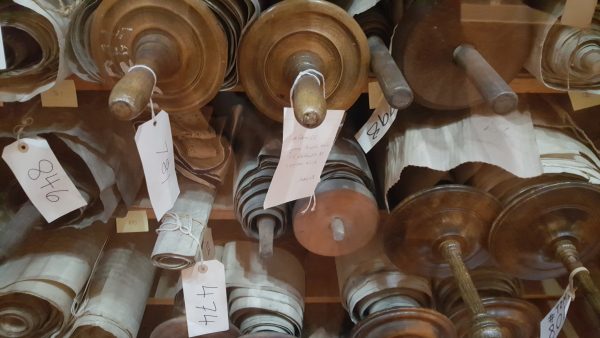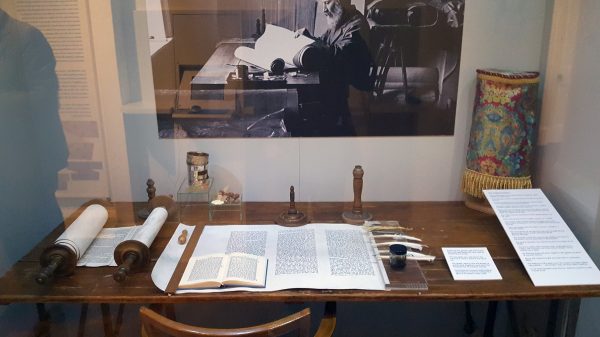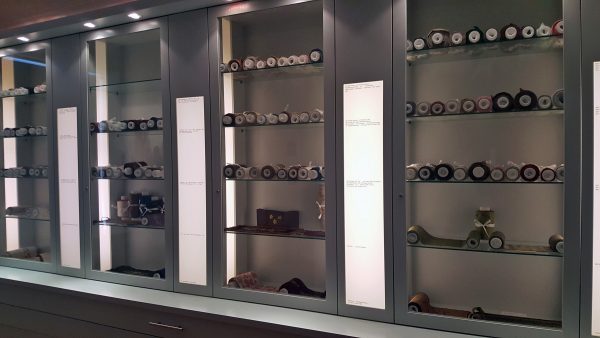Part of an occasional series where I visit museums that are open to the public, but only if you have contacted them first and arranged a time to visit.
Museums by Appointment
—
There’s a museum on a private road, behind a locked door and up several floors, that’s a remarkable survivor of Nazi and Communist oppression in Eastern Europe.
This is the museum of the Memorial Scrolls Trust, a collection of about 1,500 Torah Scrolls that were rescued from Communist Prague at the height of the Cold War.
The museum is however less about the objects within, but the story of how they escaped the Nazis and the Communists and ended up in a small room above a synagogue in a posh part of London.
It’s also a story that starts with Napoléon Bonaparte.
Why he did it is still a matter of some heated debate, but Napoléon enacted laws that gave Jews equal rights to other French citizens, and these rights were expanded to other countries that came until the control of the First French Empire.
These laws were generally opposed by the local rulers and people, but they allowed Jews to leave their ghettos and to worship openly. The rules were often tightened following Napoleon’s defeat by the British at Waterloo.
However, in the area today known as the Czech Republic, thanks to Napoléon, a large number of Jewish settlements grew up, centred on Prague and the surrounding countryside of Bohemia and Moravia.
At its height, there were over 117,000 Jews living in Bohemia, scattered in around 350 communities. As each community would have their own Synagogue, and each Synagogue would have its own hand-written Torah scroll, the country was unusually rich in such items, and other Judaica.
The Torah scroll is a long scroll containing the entire text of the Five Books of Moses, hand-written by a scribe in the original Hebrew. They are the heart of Jewish ceremonies and are read aloud in Synagogues.
Then came the Nazis.
As the Jewish population was being rounded by and deported to their deaths, people working in Prague managed to send out instructions to the communities to send them their artefacts and Jewish possessions. This was to be the core of what is today the Jewish Museum in Prague. Although working under Nazi occupation, they were able to collect as much as possible from the communities. It has been suggested that the Nazi’s wanted to create a museum to exterminated races, but it’s equally likely that they allowed the collection to build up for its financial value.
However, later a separate order went out to the increasingly decimated communities to send in their most prized possession – their Torah Scroll. And they did. In their hundreds, and eventually, it’s thought that over 1,800 scrolls were saved this way.
After WW2, the Jewish community, now numbering a few hundred people had neither resources or manpower to do much with this collection, and it was stacked up in a Synagogue on the edge of Prague, and under the equally oppressive Communist rule, left to rot.
Torah Scrolls, being written on animal hide don’t like the damp, and had they been left there, it’s unlikely that anything would survive today.
Then something quite miraculous happened.
A London based art dealer, Eric Estorick, with connections to Eastern Europe heard about this collection of scrolls slowly decaying in Prague. He was able to negotiate with the Czech government to buy the scrolls from them on behalf of a London collector, Ralph Yablon. The Czechs doubtless saw little of value in the old parchments, so sold them off when they were in need of foreign currency to support the sagging economy.
So, the scrolls came to London.
But what to do with them.
To a person of faith, they are of the most incredible value, but to anyone else, they are interesting, but not that interesting. Something to end up in an archive somewhere, safe, preserved, but unseen and unusued.
This is where the Memorial Trust had their great idea.
The Jewish population around the world was recovering from the effects of war, and population growth alone meant more Synagogues were being built. Each would need a Torah scroll, but these, handwritten documents take a year or more to produce and are incredibly expensive. The printing press hasn’t reached this holy part of the Jewish faith.
What better than to take a tale of Jewish oppression and holocaust and turn it into something better, something hopeful, something that can reach Jews across the world.
And thus a new mission was born, to restore the damaged scrolls and dispatch them to Synagogues in need.
A deeply religious scribe turned up one day in London looking for work. He spent the next 27 years working in a small room to restore the damaged scrolls, so that they could be returned to a Jewish community somewhere that needed a scroll.
Today, the majority of the scrolls have been distributed to places as scattered as Australia, Armenia, Argentina, the USA, Canada, South Africa.
Around 130 scrolls remain in London, the heart of this most unusual museum, either because they are waiting restoration, or they have been returned back by Synagogues that no longer need them, to be dispatched once again to a place in need.
The Trust has been at work since the scrolls arrived in London, but museum was opened a decade ago, in 2008, to show off not just the scrolls, but also another curious, if slightly controversial part of the collection.
Each scroll is held closed by a binder, traditionally made from the linen or fine cotton diaper used at a boy’s circumcision. The trust acquired around 400 such binders, but, depending on who you speak to, maybe the agreement to sell the scrolls didn’t include the binders as well. Or maybe the Communists weren’t fussed, but the Prague museum was very fussed.
Only in recent years has the ownership dispute been settled, amicably, and there is now a room filled with rolled up binder scrolls. Often beautifully decorated, the display is almost something you might expect to see in a fine haberdashers or fashion shop, not a religious collection.
But, with a bit of a grand flourish, two doors are opened, and here in a darkened room are the scrolls themselves. The heart of the collection in a formidable display. Modern glass and steel surrounding old wooden shelves holding the precious scrolls in various states of repair.
As a collection from around Bohemia, they reflect their parentage in the wooden end pieces, some of which are of a rustic simplicity, and others of fine ivory and detailing.
As fascinating as it is to see the collection up close and study the scrolls as individual objects, it’s the story that makes them such an exciting collection to see. The story of their near destruction, their saving, their rescue, and their new life.
Could the scribes who worked in the 18th and 19th centuries, carefully writing a scroll for a rural community have ever expected the journey their works would eventually undertake?
As a museum, it could have been a dry collection of historical documents, or a memorial to the holocaust, of interest, but not that interesting. Instead this small room in London has become the heart of a living community that spans the globe and beings joy to thousands of worshipers.
What a remarkable life those scrolls have had.
—
The Memorial Scrolls Trust is currently available to visit by appointment only (book via their website), although they aspire to move to a new room that’s easier to get to and make the museum more accessible to visitors.













Awesome article & fascinating. Thank you.